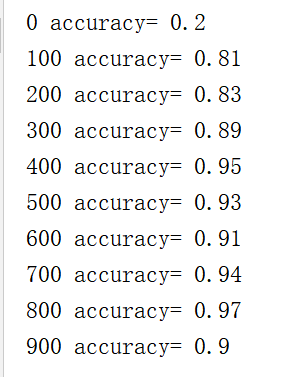Fine-tuning based on TensorFlow is essentially the same as fine-tuning based on caffe, except that caffe only needs to modify the configuration file, and TensorFlow modification is also a configuration file, but a configuration file written in python.
The essence of fine-tuning is: moving flowers to join trees.
This article describes how to do fine-tuning based on lenet.
The original network, FC1 and FC2, now want to add a layer between FC1 and FC2, that is, to form FC1--->FC2-->FC3
fine-tuning step
1. Load the model pb file.
2. Get the tensor of input and label.
3. Obtain the tensor of the layer (fc1) that needs to be modified.
4. Define the modified layer and loss, optimization, etc.
5. Fill in the data and start fine-tuning.
[The original network is as follows]
import tensorflow as tf
from tensorflow.examples.tutorials.mnist import input_data
from tensorflow.python.framework import graph_util
mnist = input_data.read_data_sets(train_dir=r"E:\mnist_data",one_hot=True)
#定义输入数据mnist图片大小28*28*1=784,None表示batch_size
x = tf.placeholder(dtype=tf.float32,shape=[None,28*28],name="input")
#定义标签数据,mnist共10类
y_ = tf.placeholder(dtype=tf.float32,shape=[None,10],name="y_")
#将数据调整为二维数据,w*H*c---> 28*28*1,-1表示N张
image = tf.reshape(x,shape=[-1,28,28,1])
#第一层,卷积核={5*5*1*32},池化核={2*2*1,1*2*2*1}
w1 = tf.Variable(initial_value=tf.random_normal(shape=[5,5,1,32],stddev=0.1,dtype=tf.float32,name="w1"))
b1= tf.Variable(initial_value=tf.zeros(shape=[32]))
conv1 = tf.nn.conv2d(input=image,filter=w1,strides=[1,1,1,1],padding="SAME",name="conv1")
relu1 = tf.nn.relu(tf.nn.bias_add(conv1,b1),name="relu1")
pool1 = tf.nn.max_pool(value=relu1,ksize=[1,2,2,1],strides=[1,2,2,1],padding="SAME")
#shape={None,14,14,32}
#第二层,卷积核={5*5*32*64},池化核={2*2*1,1*2*2*1}
w2 = tf.Variable(initial_value=tf.random_normal(shape=[5,5,32,64],stddev=0.1,dtype=tf.float32,name="w2"))
b2 = tf.Variable(initial_value=tf.zeros(shape=[64]))
conv2 = tf.nn.conv2d(input=pool1,filter=w2,strides=[1,1,1,1],padding="SAME")
relu2 = tf.nn.relu(tf.nn.bias_add(conv2,b2),name="relu2")
pool2 = tf.nn.max_pool(value=relu2,ksize=[1,2,2,1],strides=[1,2,2,1],padding="SAME",name="pool2")
#shape={None,7,7,64}
#FC1
w3 = tf.Variable(initial_value=tf.random_normal(shape=[7*7*64,1024],stddev=0.1,dtype=tf.float32,name="w3"))
b3 = tf.Variable(initial_value=tf.zeros(shape=[1024]))
#关键,进行reshape
input3 = tf.reshape(pool2,shape=[-1,7*7*64],name="input3")
fc1 = tf.nn.relu(tf.nn.bias_add(value=tf.matmul(input3,w3),bias=b3),name="fc1")
#shape={None,1024}
#FC2
w4 = tf.Variable(initial_value=tf.random_normal(shape=[1024,10],stddev=0.1,dtype=tf.float32,name="w4"))
b4 = tf.Variable(initial_value=tf.zeros(shape=[10]))
fc2 = tf.nn.bias_add(value=tf.matmul(fc1,w4),bias=b4)
#shape={None,10}
#定义交叉熵损失
# 使用softmax将NN计算输出值表示为概率
y = tf.nn.softmax(fc2,name="out")
# 定义交叉熵损失函数
cross_entropy = tf.nn.softmax_cross_entropy_with_logits(logits=fc2,labels=y_)
loss = tf.reduce_mean(cross_entropy)
#定义solver
train = tf.train.AdamOptimizer(learning_rate=0.0001).minimize(loss=loss)
#定义正确值,判断二者下标index是否相等
correct_predict = tf.equal(tf.argmax(y,1),tf.argmax(y_,1))
#定义如何计算准确率
accuracy = tf.reduce_mean(tf.cast(correct_predict,dtype=tf.float32),name="accuracy")
#定义初始化op
init = tf.global_variables_initializer()
#训练NN
with tf.Session() as session:
session.run(fetches=init)
for i in range(0,1000):
xs, ys = mnist.train.next_batch(100)
session.run(fetches=train,feed_dict={x:xs,y_:ys})
if i%100 == 0:
train_accuracy = session.run(fetches=accuracy,feed_dict={x:xs,y_:ys})
print(i,"accuracy=",train_accuracy)
#训练完成后,将网络中的权值转化为常量,形成常量graph,注意:需要x与label
constant_graph = graph_util.convert_variables_to_constants(sess=session,
input_graph_def=session.graph_def,
output_node_names=['out','y_','input'])
#将带权值的graph序列化,写成pb文件存储起来
with tf.gfile.FastGFile("lenet.pb", mode='wb') as f:
f.write(constant_graph.SerializeToString())
[fine-tuning file is as follows]
import tensorflow as tf
from tensorflow.examples.tutorials.mnist import input_data
import numpy as np
mnist = input_data.read_data_sets(train_dir=r"E:\mnist_data",one_hot=True)
pb_path = r"C:\Users\ThinkPad\PycharmProjects\tf\TensorFlow\fine-tuning\mnist\lenet.pb"
#导入pb文件到graph中
with tf.gfile.FastGFile(pb_path,'rb') as f:
graph_def = tf.GraphDef()
graph_def.ParseFromString(f.read())
_ = tf.import_graph_def(graph_def, name='')
with tf.Session() as session:
#获取输入tensor
x = tf.get_default_graph().get_tensor_by_name("input:0")
#获取标签ensor
y_ = tf.get_default_graph().get_tensor_by_name("y_:0")
#进行fine-tuning
#获取fc1
fc1 = tf.get_default_graph().get_tensor_by_name("fc1:0")
#定义新的FC2
# FC2
fc2_w = tf.Variable(initial_value=tf.random_normal(shape=[1024, 512], stddev=0.1, dtype=tf.float32, name="w4"),name="fc2_w")
fc2_b = tf.Variable(initial_value=tf.zeros(shape=[512]),name="fc2_b")
fc2 = tf.nn.bias_add(value=tf.matmul(fc1, fc2_w), bias=fc2_b)
# FC3
fc3_w = tf.Variable(initial_value=tf.random_normal(shape=[512, 10], stddev=0.1, dtype=tf.float32, name="w4"),name="fc3_w")
fc3_b = tf.Variable(initial_value=tf.zeros(shape=[10]),name="fc3_b")
fc3 = tf.nn.bias_add(value=tf.matmul(fc2, fc3_w), bias=fc3_b)
y = tf.nn.softmax(fc3, name="out")
# 定义交叉熵损失函数
cross_entropy = tf.nn.softmax_cross_entropy_with_logits(logits=fc3, labels=y_)
loss = tf.reduce_mean(cross_entropy)
# 定义solver
train = tf.train.AdamOptimizer(learning_rate=0.0001).minimize(loss=loss)
# 定义正确值,判断二者下标index是否相等
correct_predict = tf.equal(tf.argmax(y, 1), tf.argmax(y_, 1))
# 定义如何计算准确率
accuracy = tf.reduce_mean(tf.cast(correct_predict, dtype=tf.float32), name="accuracy")
# 定义初始化op
init = tf.global_variables_initializer()
session.run(init)
for i in range(0,1000):
xs, ys = mnist.train.next_batch(100)
session.run(fetches=train,feed_dict={x:xs,y_:ys})
if i%100 == 0:
train_accuracy = session.run(fetches=accuracy,feed_dict={x:xs,y_:ys})
print(i,"accuracy=",train_accuracy)
The result is as follows:
